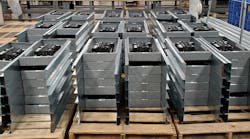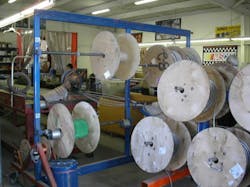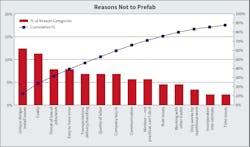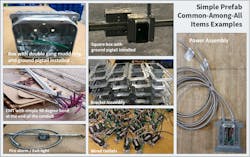Think back 10 years ago. In 2013, were you:
- Prefabricating total electrical systems?
- Prefabricating easy/repetitive items?
- Trying to get started with prefab?
- Unaware or unsure of what prefab would do for you or your business?
- Against prefab?
Over the course of a decade, the electrical construction industry has not only made prefab the norm, but also an expectation. Customers now prequalify, require, and measure/compare the amount of prefab electrical contractors (ECs) will do on their jobs. As a result, many ECs have expanded into their second or third prefabrication facility, after seeing the results of what prefab can do for them. So what is next?
In an effort to connect the dots forward, this article provides an overview of the evolution of prefab, including examples and data proving the benefits of prefabrication. MCA, Inc. is also pleased to announce the industry’s first standard on prefabrication: NECA 5-2022, Recommended Practice for Prefabrication of Electrical Installations for Construction, part of the National Electrical Installation Standards (NEIS®) series published by the National Electrical Contractors Association (NECA). Just as MCA contributed to the industry’s first productivity measurement standard (ASTM E2691-20: Standard Practice for Job Productivity Measurement Annual Book of ASTM Standards Vol 4-12, ASTM International, West Conshohocken, PA 2022), it has turned research and clinical application into an industry-wide standard practice. A key objective of NECA 5 is to assure quality in the process and products of prefabrication by ECs, bringing confidence to their customers and owners.
Independent of where you were 10 years ago, after reading this article, you should be thinking 10 years ahead about things like:
- Prefab Building™: building the project with prefabricated assemblies and sub-assemblies. In other words, rather than building the job at the site with individual components and sometimes installing prefabbed items, Prefab Building means building with prefabricated assemblies for the majority (50% plus) of the work at the job site itself. Getting to this point requires more planning for the prefabrication and its production; but more critically, it requires a plan for job-site handling and installation of mostly prefabbed elements. The key differences here include:
- Material handling and tools to accommodate assemblies/subassemblies.
- Field crew install instructions.
- QA/QC at field interfaces with feedback loop to the prefab production.
- Change management process to handle both job site and prefab shop schedule changes.
- Prefab Thinking™: planning the entire project with prefab in mind. This takes Prefab Building to the next level with the objective to avoid any manipulations at the job site with every system ready for final connections and installation. Getting to this point requires a different approach to planning and executing the work that does not rely on the time and space of the job site. For example:
- Vendors are utilized for sub-assemblies and all on-site logistics (no trades are used to move or handle material).
- Shift in resources, from job-site manpower doing majority of the work to off-site manpower doing majority of the work.
- Shift in decision-making, from the job site to the project team, prefabrication, and, ultimately, standardized processes and the supply chain all informed by the trades’ knowledge and experience.
- Externalizing Work®: challenge yourself/your project teams to answer what can’t be done away from the job site.
- Process of Prefabrication™ that goes beyond any single project or production operation.
- Agile Intelligence™: using the data from the estimating, operations (on-site and off-site) and accounting to model prefabrication, productivity, and profitability well before the job begins and during the job for feedback.
- Increasing throughput: putting more electrical construction put in place (ECPIP) per electrician by doing more work independent of time and space of the job site.
The evolution of prefab
Photo 1 and Photo 2 illustrate some classic prefab images from the early 2000s — where pioneers used prefabrication sometimes out of necessity to do large and fast-pace projects but then realized the benefits — and kept expanding. Despite these initial sparks, many ECs and electricians were opposed to prefab. In fact, while teaching a class to more than 120 electrical contracting firm owners, managers, project managers (PMs), and field leads, MCA, Inc. asked the group for their current paradigms about prefab. With more than 100 reasons for why “not to prefab” (shown in summary in Fig. 1), needless to say, it was a challenge to continue pushing for prefab with such a pushback from the industry. However, Dr. Perry Daneshgari (along with other pioneers such as Kevin Lytle, who is now with Allfab Group) continued the charge with simple advice:
- Ask your electricians in the field about their needs.
- Identify the types of work.
- Identify the types of prefab.
- Set up the structure to support:
- Prefab shop
- Processes and procedures
- Inventory management
- Procurement management
- Vendor relationship management
A key challenge to overcome was (and still is) measuring the benefits of prefab, many of which are not easily quantified by most ECs. When work is done in a controlled environment, there are fewer obstacles than would be encountered on the job site. Even if the same crew mix is doing the work at the shop, they have less trade interference, less time looking for material, shorter distances to break, and a safer environment to work in.
How do you measure those? MCA, Inc. has used SIS® (read “The Secret to Short-Interval Scheduling” for more information) as one mechanism, proving that obstacles to scheduled work are less present on jobs that use more prefab. Measuring the impact of prefabrication on productivity is also challenging. Many companies attempt comparative time studies of work done in prefab versus on site. While this method provides some production data (units per time), it is not an apples-to-apples comparison of the conditions and environments. Therefore, it will not provide a full view of impact on productivity.
Figure 2 provides an example of JPAC® (based on E2691) measuring prefabrication as a separate cost code (accounting for 9.6% of the project’s work, showing early productivity struggles but eventually stable and 20% to 30% better productivity than planned, with the overall project showing the same stable productivity differential and 10% better than planned.
A reliable indicator of prefab’s impact on a project — and company-wide — is to measure composite rate and throughput. Both measures compare how effectively highly skilled, highly trained, and highly paid electricians are being utilized. The less they’re used for installation, material movement, simple builds, and dealing with obstacles either internal to their crews or external to the job site, the more effective their training and brainpower can be used for quality outcomes. Figure 3 shows a study within one company proving that more prefabrication leads to exponential reductions in composite rate.
In 2021, MCA, Inc. conducted a research focus group to see “what’s next after prefab.” Following is a summary of predictions Dr. Daneshgari expects to materialize as a result of Prefab Thinking and Prefab Building, which goes beyond a single order, single job, single assembly, and single shop:
- New breed of contractors will be forming to replace traditional ones.
- New breed of distributors will be forming.
- Digitalization, commonization, and interconnection (DCI construction™) will connect the distributors, manufacturers, and contractors seamlessly.
- Current distributors with very low first time pass in their warehouse, which focus on project management only with brute force, will give way to the ones that will use Toyota Production System or completely disappear.
- A global architecture, engineering, and construction consortium will replace current segmented industry.
- Cost, time, and quality of shelter, which is the main objective of construction to satisfy the basic human needs, will be reduced to affordable levels of 25% to 30% of annual income vs. 300% to 600% at the current time.
In the same research, 45% of participants in the focus group had been doing prefabrication for less than five years, and 82% of participants were prefabbing less than 10% of their work. More than half of electrical work currently done on-site can be done off-site. Once the industry gets to that level, a new ecosystem will be needed. To see where you stand, feel free to complete the Prefabrication Litmus Test.
Introducing the industry’s first prefabrication standard from NEIS
When Henry Ford envisioned the assembly line, he may not have foreseen the need for gas stations. When Guttenberg envisioned the printing press, he probably did not have libraries in mind. When Eli Whitney built the first musket, he was not considering the need for bulletproof vests. Each of these pioneers that transferred tacit to explicit knowledge brought unforeseen expansion that required new regulations, infrastructure, and operating models.
As the industry moves forward with the evolution of prefab, the need for standardization increases. With this in mind, NECA’s Codes & Standards Department worked with MCA, Inc. over the past two years to develop NECA 5-2022. The National Electrical Installation Standards (NEIS®) are used by construction owners, specifiers, and contractors to clearly illustrate the performance and workmanship expectations, in this case of Prefabrication. In MCA, Inc.’s research on The Industrialization of Construction®: Signal or Noise? Threat or Promise?, we outlined an Advanced Model for industrialization, with a key component being new boundaries in the form of regulations, standards, and technology and innovation. NECA 5-2022 is one step in the right direction. The standard recommends practices and processes for assuring outcome of prefabrication installations, with focuses on three things:
- Material
- Work
- Information
A key (and often unspoken) concern for electricians to do more prefab is loss of control or assurance in the outcome that their license must uphold. In other words, once a Model T was no longer built one at a time by one single mechanic, the assurance of quality in its outcome went out the window. Ford had to design and use a process that replicated the tacit knowledge of its mechanics, standardizing the work to the extent that every car could be produced by multiple people the same way it would have been produced by a master mechanic. We need the same thing in electrical construction, and it requires standard process and procedures for material, work, and information flow. Do any of the following sound like your current prefab operation:
- The field calls in orders to the shop for next-day production and delivery.
- Prefab can’t move forward with production because it doesn’t know where the material stands that was ordered by the PM.
- The field receives prefab assemblies just like it receives anything from a supplier — by surprise and without look ahead.
- You can’t prefab until the BIM/VDC modeling is far enough along to produce spool drawings/cut sheets.
If you answered “yes” to any of them, you should get a copy of NECA 5-2022 and start digesting/building your processes to get past these roadblocks.
Putting it into practice
The standard practice includes eight steps, each one with guidance on material, information, and workflow. The six key processes are listed below and highlighted in MCA, Inc.’s Prefabrication Handbook for the Construction Industry, which includes examples, templates, and forms for all of the following:
1. Pre-construction: Planning & Prefab Identification
Several EC&M articles, such as “Why Paying Attention to Branch Circuit Work on Electrical Jobs is So Important” can provide background on why and how to do a Work Breakdown Structure™ (WBS). The standard practice includes this process as the means to manage and plan the work for Prefab Building. The outcome of a collaborative WBS should include a prefabrication plan, categorized into three types:
- Common prefab items
- Type-of-work-specific prefab items
- Build-to-order prefab items
Examples of each are shown in Figure 4. These types will determine how the work, material, and information flow (including BIM and material supplier interactions) will occur.
The practice does not require that prefab was identified, assumed, or incorporated during estimating. MCA, Inc.’s research on “Estimating and Pricing with Prefab” from 2020 outlines a process and calculator for estimating and pricing with prefab, but clearly states that a proven process and standardized procedures for prefabrication (such as NECA 5-2022) and measurement (such as ASTM E2691) be in place before estimating uses embedded prefab pricing or assemblies.
2. Prefab Request Processes
Prefab types 1 and 2 require a prefab order form to varying degrees of standardization. Type 1 items may come from a catalog, where Type 2 likely require more job-specific sketches and measurements. Field-to-shop validation of the request is a critical component of the Standard Practice’s Quality Assurance, not only for the “what” will get built, but also for the “when” it will get built to allow for QC in the prefab production. The standard recommends lead times for prefab requests as follows:
- Type 1 prefab: minimum of 72 hours
- Type 2 prefab: minimum of 5 days
- Type 3 prefab: 10 to 14 days for single-trade assemblies, but will vary widely and increase for multi-trade prefab
Naturally, the lead time requires planning and utilization of a WBS process that dedicates time for the project team (field lead, project manager, prefab manager, procurement & logistics team) to do Prefab Thinking, as opposed to just the traditional mindset after award that usually prioritizes “order material” and “get on site to start building.”
3. Production Process
Similar to the planning and request processes, the production process, including material, work, and information flow, hinges on the type of prefab requested. According to MCA, Inc.’s research, 83% of ECs have a prefab shop, but many of these were set up as “extensions of the job site” — both in terms of their physical layout and work planning/supervision. NECA 5-2022 lays out processes and procedures for the shop to function independently and effectively to ensure safety and strict QA/QC processes.
4. Logistics & Transportation Process
As discussed previously, Dr. Daneshgari laid out “what’s next after prefab” with foresight into transformation required in the distribution industry to support expansion of prefabrication. The processes between post-production in the fab shop and installation at the job site are likely the biggest current gap to Prefab Building and improved quality in outcome. Labeling, as one example of what seems to be a “simple” activity, is a key part of NECA 5-2022.
If an individual component of a stick build shows up from a material supplier, such as a bundle of pipe or a box of couplings, they will often get moved to a common laydown area or hopefully a VMI crib. When prefab shows up to the job site, it is built to be installed in a specific area and in a specific way. To ensure that this “assembly” makes it to that destination, some information needs to be added to the “shipping label” either coming from the prefab shop or from a supply house such as:
- Job-site install location
- Assembly components/bill of materials
- Install instructions (for more complicated assemblies)
5. On-Site Installation Process
The final quality assurance of Prefab Building is in the installation of prefabricated assemblies and sub-assemblies. Prefab should be delivered at a justified time and location at the job site with minimal buffers. This requires significant increases in information management across job site, prefab shop, and distributor partners to know what material (including prefab) is where as well as where it is going next.
Overview
Prefab in the electrical construction industry has evolved — from initial criticism (“it’s going to replace us”) to skepticism (“I’ll try a few things, but it’s typically just easier to build it in the field”) to where we are today (“prefab has reduced my liability, improved my safety, quality, and on-time delivery through externalizing work”).
This is the same path many other industries have taken — sometimes out of innovation; other times out of necessity. The irreversible workforce shortage is providing necessity to do more work with fewer electricians, and prefab is one solution to externalizing work, where the question goes from “what can we prefab?” to “what cannot be done off site?” The ultimate outcome is improved productivity, which will drive a better outcome for construction consumers and more work for electrical contractors. Hopefully, this article can help you see the past, present, and future for not only the electrical industry but also your company.
Dr. Perry Daneshgari is president and CEO of MCA, Inc., Grand Blanc, Mich. He can be reached at [email protected]. Dr. Heather Moore is vice president of operations. She can be reached at [email protected].









